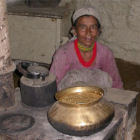
Renewable energy could help boost economies in the Himalayan region
Flickr/International Rivers
[KATHMANDU] Himalayan countries should support and invest in green
technologies if such initiatives are to succeed and bring benefits to
the economy in the long term, a meeting has heard.
Eight countries in the Hindu-Kush Himalayan region are making progress in development and uptake of renewable energy technologies, which can maintain sustainable economic growth for mountain communities, a workshop in Kathmandu heard earlier this month (2–4 November).
Further investments could provide environmental, social and economic benefits to mountain communities, experts told the meeting, which was organised by the International Centre for Integrated Mountain Development (ICIMOD).
But it is uncertain whether poorer countries could sustain investment in green technology development without external support and this dependency on donor funding could hamper the progress made so far, experts warned.
Suresh Kumar Dhungel, senior scientist at Nepal National Academy of Science and Technology, told SciDev.Net: "The sad part is that Nepal's efforts are not solely ours, it is all guided by funds from international donor agencies. Policymakers need to realise the importance of a green society."
Eight countries in the Hindu-Kush Himalayan region are making progress in development and uptake of renewable energy technologies, which can maintain sustainable economic growth for mountain communities, a workshop in Kathmandu heard earlier this month (2–4 November).
Further investments could provide environmental, social and economic benefits to mountain communities, experts told the meeting, which was organised by the International Centre for Integrated Mountain Development (ICIMOD).
But it is uncertain whether poorer countries could sustain investment in green technology development without external support and this dependency on donor funding could hamper the progress made so far, experts warned.
Suresh Kumar Dhungel, senior scientist at Nepal National Academy of Science and Technology, told SciDev.Net: "The sad part is that Nepal's efforts are not solely ours, it is all guided by funds from international donor agencies. Policymakers need to realise the importance of a green society."
Golam Rasul, head of ICIMOD's economic analysis division said: "The
initial cost of renewable energy is high compared with fossil fuel based
energy. The technology we are using now is not very cost-effective.
Technologically advanced countries should support research in this
field."
Rasul said regional cooperation and transboundary energy trade could offer a way out.
"Bhutan and Nepal have huge hydropower potential but lack technical capacity and large markets, whereas India and Bangladesh are power hungry," Rasul said.
Ghulam Mohammad Malikyar, deputy director-general of the National Environmental Protection Agency, of the Afghanistan, told SciDev.Net climatic environments may need different green technologies, appropriate for local circumstances.
Prem Pokhrel, climate and energy programme officer at the Alternative
Energy Promotion Centre, Nepal, said that almost a million households
in Nepal are benefiting from micro-hydro power plants,
improved cooking stoves, domestic biogas plants, and solar home
systems. This saves an estimated 12 million tonnes of carbon dioxide
emissions each year.
Pokhrel described an 'energy ladder' of rising income, where
households transition from wood and animal-based fuels to electricity
and other clean energy, as they get richer. This also translated into
better health for women and children, said Pokhrel. He added that uptake of clean energy can also help generate better income.
ICIMOD organised a conference on Green Economy and Sustainable Mountain Development: Opportunities and Challenges in View of Rio+20 in September, which produced a concept paper 'Green Economy for Sustainable Mountain Development'.
ICIMOD organised a conference on Green Economy and Sustainable Mountain Development: Opportunities and Challenges in View of Rio+20 in September, which produced a concept paper 'Green Economy for Sustainable Mountain Development'.
One of the key recommendations to the national governments from the
concept paper was to "adopt alternative forms of energy such as
hydropower, wind power, biogas, and solar energy to reduce negative
impacts from the use of fossil fuels and fuel wood".
Link to 'Green Economy for Sustainable Mountain Development: a concept paper for Rio+20 and beyond'
Link to 'Green Economy for Sustainable Mountain Development: a concept paper for Rio+20 and beyond'
 Image via CrunchBase
Image via CrunchBase